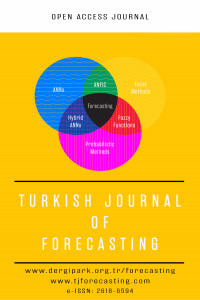The Effect of Handling Imbalanced Datasets Methods on Prediction of Entrepreneurial Competency in University Students
The Effect of Handling Imbalanced Datasets Methods on Prediction of Entrepreneurial Competency in University Students
Machine Learning, Imbalance Data, Handling Imbalanced Dataset Methods Entrepreneurs, Classification,
___
- [1] R. C. Ramona, “The Importance Of Entrepreneurs In The ‘New Economy’”, Managerial Challenges of the Contemporary Society, Issue 2, pp. 265-269, Jun. 2011.
- [2] R. W. Fairlie and W. Holleran, “Entrepreneurship training, risk aversion and other personality traits: Evidence from a random experiment”, Journal of Economic Psychology, vol. 33, pp. 366-378, Apr. 2012.
- [3] S. P. Kerr, W. R. Kerr and M. Dalton, “Risk attitudes and personality traits of entrepreneurs and venture team members“, Proceedings of the National Academy of Sciences of the United States of America, vol. 116, pp. 17712-17716, Sep. 2019.
- [4] M. Brandt and S. STEFÁNSSON, “The personality venture capitalists look for in an entrepreneur: An artificial intelligence approach to personality analysis”, M. Sci. thesis, KTH Royal Institute of Technology, Stockholm, Sweden, Jun. 2018.
- [5] M. Caliendo, F. Fossen and A. S. Kritikos, “Personality characteristics and the decisions to become and stay self-employed”, Small Business Economics, vol. 42, pp. 787-814, Oct. 2013.
- [6] F. U. Salmony and D. K. Kanbach, “Personality trait differences across types of entrepreneurs: a systematic literature review”, Review of Managerial Science, vol. 16, pp. 713-749, Apr. 2021.
- [7] M. Castillo-Palacio, R. M. Batista-Canino, A. Zuñiga-Collazos, “The Relationship between Culture and Entrepreneurship: From Cultural Dimensions of GLOBE Project”, Scientific Annals Of Economics and Business, vol. 67, pp. 517-532, Mar. 2020.
- [8] C. J. Boudreaux, B. N. Nikolaev, and P. Klein, “Socio-cognitive traits and entrepreneurship: The moderating role of economic institutions”, Journal of Business Venturing, vol. 34, pp.178-196, Jan. 2019.
- [9] D. V. Moudrý and P. Thaichon, “Enrichment for retail businesses: How female entrepreneurs and masculine traits enhance business success”, Journal of Retailing and Consumer Services, vol. 54, May 2020.
- [10] B. Graham and K. Bonner, “One size fits all? Using machine learning to study heterogeneity and dominance in the determinants of early-stage entrepreneurship”, Journal of Business Research, vol. 152, pp.42-59, Nov. 2022.
- [11] M. G. Celbiş, “A machine learning approach to rural entrepreneurship”, Papers in Regional Science, vol. 100, pp. 1079-1104, Jan. 2021.
- [12] U. Sharma and N. Manchanda, “Predicting and Improving Entrepreneurial Competency in University Students using Machine Learning Algorithms”, in 10th International Conference on Cloud Computing, Data Science & Engineering (Confluence), 2020, pp. 305-309.
- [13] N. Manchanda and U. Sharma (2019) [Online]. Available: https://www.kaggle.com/datasets/namanmanchanda/entrepreneurial-competency-in-university-students
- [14] Y. Sun, A. K. C. Wong, and M. S. Kamel, “Classification of Imbalanced Data: A Review”, International Journal of Pattern Recognition and Artificial Intelligence, vol. 23, pp. 687-719, 2009.
- [15] A. Somasundaram and U. S. Reddy, “Data Imbalance: Effects and Solutions for Classification of Large and Highly Imbalanced Data”, in 1st International Conference on Research in Engineering, Computers and Technology (ICRECT 2016), 2016.
- [16] H. Ali et al., “A review on data preprocessing methods for class imbalance problem”, International Journal of Engineering &Technology, vol. 8, pp. 390-397, 2019.
- [17] N. V. Chawla et al., “SMOTE: Synthetic Minority Over-sampling Technique”, Journal of Artificial Intelligence Research, vol. 16, pp. 321–357, Jun. 2002.
- [18] R. Blagus and L. Lusa, “SMOTE for high-dimensional class-imbalanced data”, in 11th International Conference on Machine Learning and Applications Machine Learning and Applications, 2012, paper 2, pp. 89-94.
- [19] Md. A. Sahid et al., “Effect of Imbalance Data Handling Techniques to Improve the Accuracy of Heart Disease Prediction using Machine Learning and Deep Learning”, in IEEE Region 10 Symposium (TENSYMP), 2022.
- [20] M.V. Joshi, V. Kumar, and R.C. Agarwal, “Evaluating Boosting Algorithms to Classify Rare Classes: Comparison and Improvements”, in Proceedings 2001 IEEE International Conference on Data Mining, 2001, pp. 257-264.
- Yayın Aralığı: Yılda 2 Sayı
- Başlangıç: 2017
- Yayıncı: Giresun Üniversitesi
Ahmet Furkan BAYRAM, Caglar GURKAN, Abdulkadir BUDAK, Hakan KARATAŞ
Ahmet Furkan BAYRAM, Caglar GURKAN, Abdulkadir BUDAK, Hakan KARATAŞ
